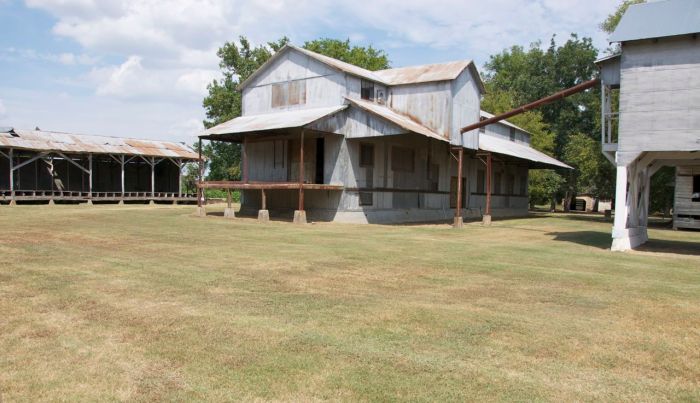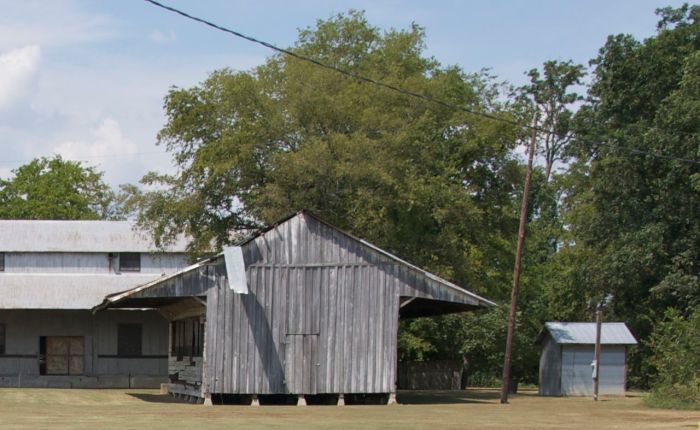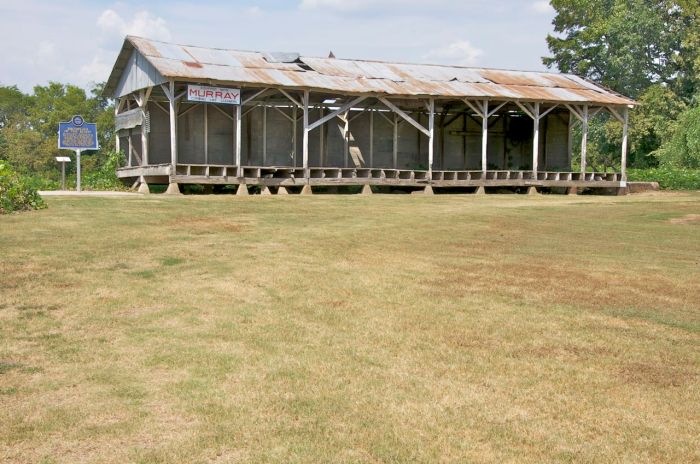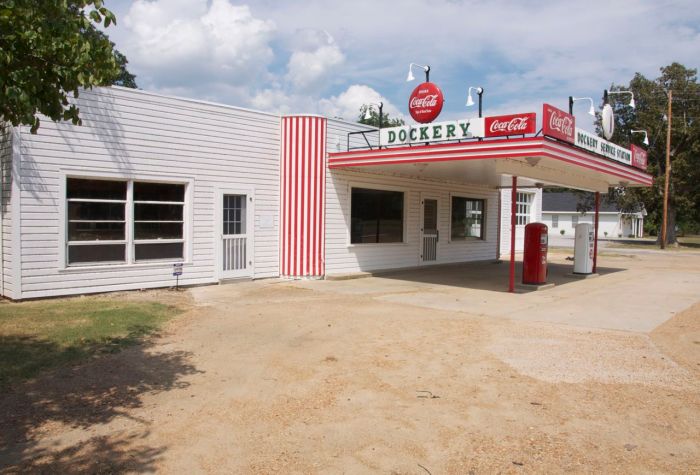Dockery Farms, number three in the Delta regional poll for the 101 Places in Mississippi to see before you die, was established in 1895 “to produce cotton, America’s biggest export at the time” (DockeryFarms.org). Located on Highway 8 between Cleveland and Ruleville, the Dockery Farms
…complex consists of 8 buildings and 1 structure that were designed and built by Will Dockery and his farm workers in the 1920s and 30s. In addition, there is one site of 1 ruin. All of these buildings constitute a unique site that is original with minimum repairs performed by farm workers over the years. The Dockery Farms location is a fine example of Mississippi plantation early twentieth century agricultural buildings designed and built by a landowner and his workers. The sign on the Seed House is a well-known symbol associated with the origins of American blues music. (William Lester, 2005, in the nomination form for the National Register of Historic Places)
The Seed House, circa 1930 is constructed of cypress, and roofed with corrugated tin (Lester, 2005). Cotton seed was stored in the building. Wagons or trucks could drive into the bay and eight trap doors in the second floor opened to release cotton seed into the wagon or truck.
The cotton gin, also circa 1930, has steel frame construction on a concrete foundation, with corrugated tin siding and roof (Lester, 2005). It is connected to the Seed House by the pipe that functioned to deliver the de-linted cotton seed for storage.
A mule shed/hay barn, circa 1925, is behind the Seed House. It is a cypress board-and-batten construction with a center door in the south and north sides, and open sides to provide ventilation.
The cotton storage shed, circa 1925, sits on the south bank of the Sunflower River. Cotton bales were stored in the shed prior to shipping. Like the other buildings, it is constructed of cypress wood with corrugated tin roof. The Murray Company sign is original (Lester, 2005) and the gin equipment is located inside the cotton gin. The Murray Model 90 combing lint cleaners and the Minneapolis-Moline power plant are non-functional, but original (Lester, 2005).
The Ruffin Scott house (circa 1930) is wood construction with asphalt siding with brick design, and has a corrugated tin roof (Lester, 2005). Scott was a carpenter at Dockery, and the last person to live in the house. The house, which remains original, has pine wood floors and wood plank walls and ceilings.
This cypress board-and-batten circa 1925 shed served as fertilizer storage (Lester, 2005).
The mule water trough, circa 1930, retains its original cast iron hand water pump (Lester, 2005). The steel turnbuckles that edge the concrete walls were made in the blacksmith’s shop on the farm. The trough was used by local black churches for baptisms. The ruins of the old commissary (circa 1895-1900) are visible under the tree across the road.
The service station/store, circa 1935, contained the general farm office and Joe Rice Dockery’s private office (Lester, 2005). It retains its original glass front counters, and a scale (meat scale?) is visible through one of the front windows.
Dockery Farms is the quintessential Delta plantation…Unlike many plantations of that day, Dockery Farms did not rely on sharecropping, but rather paid its laborers…Under Joe Rice Dockery’s leadership, the Farms organized an insurance and burial association for laborers, and even provided vaccination against endemic Delta diseases. The Farms also gain a reputation for dealing fairly and honestly with both Black and White workingmen, and helped many save enough money to begin farming on their own elsewhere. (Luther Brown, 2002, Dockery Farms Case Summary, as cited in Lester, 2005)
Check out the Delta Blues at Dockery Farms, and listen to the music of Charley Patton, Son House, Robert Johnson, Howlin’ Wolf, Pops Staples, and Honeyboy Edwards. As B. B. King said, “…You might say it all started right here.”
Categories: 101 MissPres Places, African American History, Blues Sites, Delta, Historic Preservation, Mississippi Landmarks










Is stewardship still under members of the Dockery family? I knew Mrs. Keith Dockery McLean when I lived in Cleveland in the 1980s, and knew that the artist Bill Lester had his studio out there. How secure is the future of these fabulous vernacular structures?
LikeLike
The link to the dockeryfarms.org will take you to information about the foundation.
LikeLike
Bill Lester was chosen by the family a few years ago to head up the foundation they established for caretaking, renovation and development of Dockery Farms. The future is quite secure and Bill is probably the most conscientous and committed person they could have chosen, The property is well-maintained and lovely.
LikeLike
I stayed at Dockery Farms as a child at my grandparents’ house. My grandfather was plantation manager. I rode around in his truck over many acres of cotton. I do remember workers picking cotton. Many summers I spent helping in the garden with my grandmother, Gertrude Storey. I was in and out of the store many a time. I knew the lady who worked there as Miss Flossie. I got to go behind the counter with the big Jackson cookie jar, metal cooler of glass bottled drinks, and the few dry goods they had. I loved going there. I was even allowed to swim in Mr. Dockery’s swimming pool as a child in the summers. Never thought it would be a tourist destination. What great memories.
LikeLike
I’m a musician/entertainer, I’ve gone by the name Doc Dockery for about 40 years now. Born in Elizabethtown, Kentucky. I love the blues, and found out about Dockery Farms about a year or so, and finally got to visit in June when my youngest daughter graduated, we stopped by, and I was so moved by this place. I stopped by the chambers of commerce and told them that I’ve played blues for years, even played at The House Of Blues in Las Vegas on a regular basis. I wrote a song and made a video called DOCKERY FARMS. I was invited to come to Dockery Farms and play the song and other originals and blues classics on Oct 1st and Oct 3rd, of 2013. I’m so greatful to be a part of their Bridging the Blues Festival, if you go to you tube and type in Dockery Farm video by Doc Dockery or Gary Doc Dockery you should be able to see the video. Looking forward, just being there!
LikeLike
My name is Donyetta Dockery. I just fond out my family comes from the The Dockery Farm. We have a page on Face Book called The Dawkins/Dockery Family Chain. There is 100s of Dockery’s on there trying to get to know of another. I will love to visit the Farm one day. I guess this is why all the Dockery’s I know have music in there blood!
LikeLike